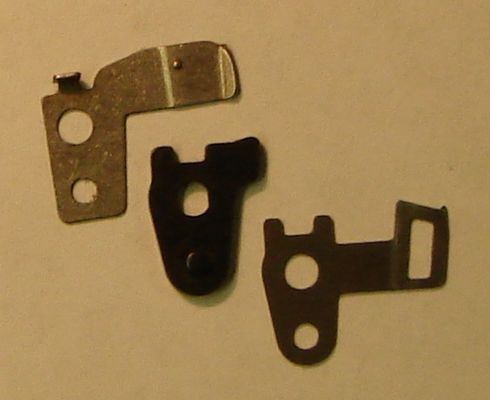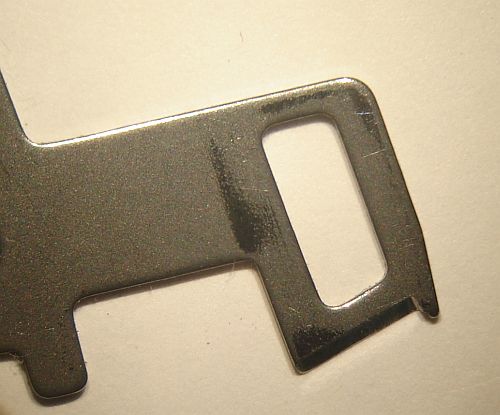Cleaning/Sharpening the ULT2001 Thread Cutter
Click image for larger view
The ULT thread cutter is generally trouble free. Occasionally, severed threads may interfere with movement of the hook preventing the cutter from operating properly, possibly slowing or stalling the motor in the cutting cycle. Cleaning the area under and around the movable hook (described on the Fixit page) and its path of movement normally corrects this problem.
The red arrow in the picture points to the sharp part of the cutter, visible when the needle plate is removed. The sharpened area of the cutter is completely visible when the hook is retracted to the left, its normal position (as shown above). Look at the pictures and description below to help recognize the cutting area of the blade, then check for threads or foreign material stuck to the sharp area -- easily possible if you use adhesive when embroidering. Adhesive and/or other foreign material can usually be removed with a drop of WD40 on a wooden toothpick (don't use metal lest you dull the cutter) without removing the cutter.
After long use and especially when metallic thread is used the cutter could become dull and might benefit from sharpening. The blade which cuts the thread is fixed in place and is identified by the yellow arrow in the above picture. The hook simply pulls the thread into this blade to cut it. The blade must be removed to sharpen it and this requires some dexterity because the parts are small and awkward to reach - tweezers are a big help as is a small offset screwdriver (a screwdriver with an L shaped handle, it provides leverage plus it needs little clearance above the screw).
 The screw which retains the cutter assembly is just to the left of the yellow arrow head in the picture (the needle plate and end cover have been removed and the machine turned so the end faces the camera). The cutter assembly is 3 parts held in a stack by this screw, as shown in this picture. The parts are aligned by the screw plus little bumps and holes these bumps fit into - this makes it hard to get it together wrong if you pay attention to getting the bumps and holes to fit together. The leftmost part in the picture fits directly onto the ULT and extends under the hook. The second part (black plastic) is a spacer that goes on top of the first part to hold the blade at the right height so it goes into the slot on the hook. The rightmost part is the blade, where the sharp section is the slanted part above the rectangular hole. The hook pulls the thread onto the sharp area and the little protrusion on the right end keeps the thread from sliding off the cutter.
The screw which retains the cutter assembly is just to the left of the yellow arrow head in the picture (the needle plate and end cover have been removed and the machine turned so the end faces the camera). The cutter assembly is 3 parts held in a stack by this screw, as shown in this picture. The parts are aligned by the screw plus little bumps and holes these bumps fit into - this makes it hard to get it together wrong if you pay attention to getting the bumps and holes to fit together. The leftmost part in the picture fits directly onto the ULT and extends under the hook. The second part (black plastic) is a spacer that goes on top of the first part to hold the blade at the right height so it goes into the slot on the hook. The rightmost part is the blade, where the sharp section is the slanted part above the rectangular hole. The hook pulls the thread onto the sharp area and the little protrusion on the right end keeps the thread from sliding off the cutter.
Look carefully at how the blade fits into the slot in the hook and remember this since you'll have to put the blade back into that slot. Loosen and remove the cutter retention screw being careful not to drop it into the works :-) Once the screw is out of the way, the blade may be grasped with tweezers and slid out of the slot in the hook. Generally the other parts of the cutter assembly are also disturbed but they are easily put back after sharpening - use care to avoid having them drop into the works, of course.
 This picture is a closeup of the bottom of the cutter blade where it has been ground to a sharp edge. Note that the little protrusion is not sharpened. Sharpening technique is up to you; a narrow piece of 400 or 600 grit carbide paper glued to a popsicle stick and used as a "file" on the sloped edge should work well. Use care to approximately match the existing slope. (We haven't needed to sharpen our cutter -- yet)
This picture is a closeup of the bottom of the cutter blade where it has been ground to a sharp edge. Note that the little protrusion is not sharpened. Sharpening technique is up to you; a narrow piece of 400 or 600 grit carbide paper glued to a popsicle stick and used as a "file" on the sloped edge should work well. Use care to approximately match the existing slope. (We haven't needed to sharpen our cutter -- yet)
Assembly is the reverse of the above disassembly. It takes a steady hand with the tweezers to get the blade into the hook's slot, after that the rest is easy.
